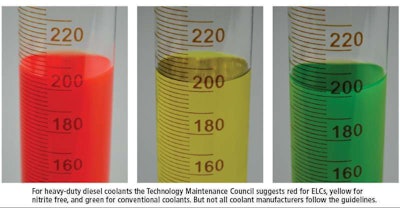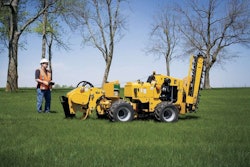
For most OEMs today ELCs are the factory fill for new equipment and trucks coming off the assembly line. But fill it and forget it? That would be unwise, possibly even catastrophic.
Even if your coolant is in perfect shape, your cooling system will not always be. Hitting those long term milestones may take five to 10 years. That’s a lot of time on any machine and a lot of time for something mechanical to go wrong and impact the cooling system indirectly. And every single person who touches the machine – operators, drivers, mechanics – introduces the possibility of human error.
“No system should be unchecked,” says Dr. Peter Woyciesjes, worldwide RD&E manager, coolants, for Prestone. “Constant maintenance and care must be given to all systems, including the coolant system to make sure the coolant level and concentration is maintained,” he says.
Checking levels
How often should you check coolant levels with ELCs? The same as you should with conventional coolants. Every day, or at least every time you fuel up, says Dr. Aleksei Gershun, technical fellow at Prestone.
With either type of coolant your system may lose up to 10 percent of its fluid per year, Gershun says. Every cooling system leaks a little. A 10 percent loss could introduce air into the system and damage the engine. “As soon as you have air in your system, you will have a problem,” Gershun says. “It doesn’t matter what type of coolant.”
The solution is simple. Make sure the operator checks the level at the start of the day or that the fuel supplier checks at the end of the day. The time it takes to twist off, look at the fluid level and reinstall the radiator cap is cheap insurance compared to a blown engine.
Scheduled maintenance
The next level of observation for ELCs should be anytime you have the truck or machine in for scheduled maintenance, says Dan Holdmeyer, industrial and coolants brand manager, Chevron. That could be anytime the equipment is in for an oil change, or at least every six months, he says.
The mechanic should check for leaks, make sure the coolant level full and check the glycol concentration. “Glycol is not very stable, whether it’s in old or new technology,” says Holdmeyer. “When it’s exposed to the air it tends to degrade pretty quickly. We recommend every six months doing a concentration test, ideally with a refractometer, which will get you to within one or two percent. They’re easy to calibrate and easy to maintain.”
Holdmeyer also recommends mechanics check the color and clarity of the fluid. If you see a lot of brown or rust, that could indicate mechanical problems or the fluid could be getting burned.
Going the distance
Claims of ELCs lasting 20,000 hours off road or a million miles on road are not unheard of.
“We almost don’t know how long it can go because when we test trucks at 600,000 miles we still see 90 percent of the coolant additive remaining,” says Stede Granger, OEM technical manager, Shell Lubricants. “When you get that far out, it’s hard to say what is a lifetime coolant. But we fully believe the coolant has the capability to last the life of the engine.”
There are two caveats, however. One is the aforementioned maintenance – daily checks and regular PMs. The other requirement is to check for nitrite and additive levels at the OEM-recommended levels or levels recommended by the coolant manufacturer.
Nitrites protect the cylinder liners from cavitation and ELCs are less prone to nitrite depletion than conventional coolants. But many coolant manufactures will not guarantee the quality of your fluid unless you check the nitrite and additive levels at around the midpoint in its life and adjust levels if necessary. A good coolant vendor will have test strips and/or sampling kits that enable you to do this.
Color confusion
When ELCs were first introduced, the Technology Maintenance Council recommended that these fluids be colored red or pink to distinguish them from conventional coolants, most of which were colored green. It was also recommended that nitrite-free coolant formulations be colored yellow.
However, not every manufacturer followed the recommendation and you should not use the fluid’s color as a guide. Set up protocols within your shop so that all your mechanics and techs know or can easily find out the brand and the type of coolant being used. Top off or replace coolant with the same product. If your operators occasionally top off as well, make sure they know to use the right coolant.
If you open up a radiator and see a muddy, brown looking fluid, it’s possible that somebody poured the wrong type of coolant into the system and mixed two colors causing the brown color. If so you’ll need to test the fluid to see if you have a cooling system problem or how much of the desired coolant has been diluted.
In an emergency you can top off a system running ELC with a conventional coolant or vise versa. They both contain water and propylene glycol or ethylene glycol. And most experts agree that it’s better to run full temporarily with a mixed coolant formula than to run low. But once you get to the point of 20 percent dilution, the effectiveness of both coolants can become compromised. You won’t have the full benefit of the point-of-corrosion protection ELCs offer and you won’t have enough solid additives to coat the inside of your radiator with a protective barrier.
You’ll also want to check your OEM specs to see if your machine or truck calls for a nitrite-free coolant. These are often yellow in color, but as with the other colors that’s no guarantee. Nitrite-free formulas evolved to better serve modern engines with higher output and aluminum radiators, says Granger. They provide better heat transfer compared to conventional coolants and are compatible with other long life coolants, he says.
Partner with a good provider
Regardless of the coolant you choose, if you are using it in heavy-duty trucks or construction machines you should partner with a provider who can offer technical expertise and a high level of services. “Not everybody who sells coolants has the ability to offer those services,” says Gershun.
A reputable supplier should be able to provide test strips for pH, nitrite and carboxylate levels; sampling services and additives for replenishment if they’re necessary; and consulting services. They should also have the expertise to know your equipment and the OEM coolant requirements.
These services are typically part of a package you buy with the coolants. “They may have a price associated with it, but those prices are a minimum compared to losing a piece of equipment,” Gershun says.













